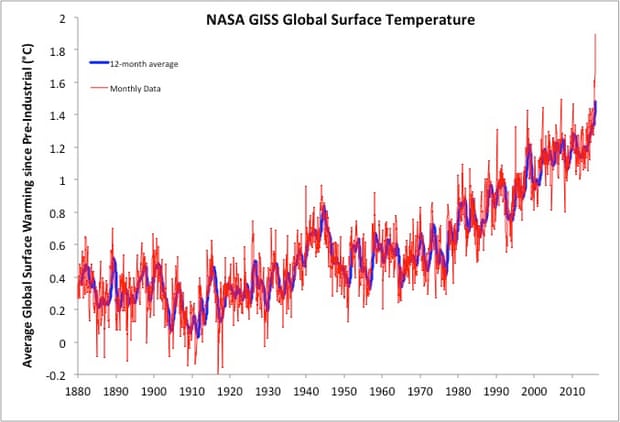
“Stunning,” “wow,” “shocker,” “bombshell,” “astronomical,” “insane,”“unprecedented”– these are some of the words climate scientists have used to describe the record-shattering global surface temperatures in February 2016.

NASA GISS global monthly (red) and 12-month average (blue) surface temperatures as compared to pre-industrial temperatures. Illustration: Dana Nuccitelli
It’s difficult to see any ‘pause’ or slowdown in the global warming over the past 50 years.
To put the current temperatures into context, prior to last October, monthly global surface temperatures had not been more than 0.96°C hotter than the 1951–1980 average, according to Nasa. The past 5 months have been 1.06°C, 1.03°C, 1.10°C, 1.14°C, and 1.35°C hotter than that average, absolutely destroying previous records. Estimates from Noaa are in broad agreement with those from Nasa.
Right now, the Earth’s average surface temperature is hotter than it’s been in thousands of years; potentially even longer.
We’re currently at the peak of a very strong El Niño event, which has brought warm water up to the ocean surface. That’s certainly played a major role in the current record-breaking temperatures. The hottest years are almost invariably years with El Niño events, although 2014 was the first year in decades to set a temperature record without an El Niño.
However, the past 6 months have been 0.43°C hotter than the corresponding months in 1997–1998. So clearly, while El Niño is a big contributor to the current record-shattering temperatures, human-caused global warming is playing a major role as well. Climate scientist Michael Mann attributed the record to approximately 50% human influences, and 50% a combination of El Niño and natural weather fluctuations.
Last December, 195 countries signed the COP21 international climate agreement in Paris. Graham Readfearn summarized the agreement for The Guardian:
The guts of the agreement hang off the so-called “long-term goal” that commits almost 200 countries to hold the global average temperature to “well below 2°C” above pre-industrial levels and to “pursue efforts to limit the temperature increase to 1.5°C”.
Depending on how exactly we define “pre-industrial,” February temperatures were between 1.5 and 2°C hotter than those in pre-industrial times. So, we’re already starting to tread on thin ice, in the range that the global community has deemed dangerously hot.
However, since we’re at the peak of an El Niño, as they did after 1998, global surface temperatures will temporarily go back down once this event is over. That is, until human-caused global warming pushes them up to and beyond these temperatures once again in the near future. As climate scientists Steve Sherwood and Stefan Rahmstorf wrote,
This is the true climate emergency: it is getting more difficult with each passing year for humanity to prevent temperatures from rising above 2?. February should remind us how pressing the situation is.
In the meantime, we’re getting a glimpse at the future climate consequences of our carbon pollution. Just to name a few, Africa is being battered by heat and drought, with more than 36 million people facing hunger across the southern and eastern parts of the continent as a result. Droughts in Vietnam and Zimbabwe have cost these countries 4% and 12% of their GDP, respectively. Arctic ice is in poor shape as a result of the region’s warmest-recorded winter. Australia has been breaking heat records as well, with 39 consecutive days in Sydney above 26? (double the previous record). And a massive coral bleaching event appears likely on the Great Barrier Reef.
Posted by dana1981 on Monday, 21 March, 2016
 |
The Skeptical Science website by Skeptical Science is licensed under a Creative Commons Attribution 3.0 Unported License. |